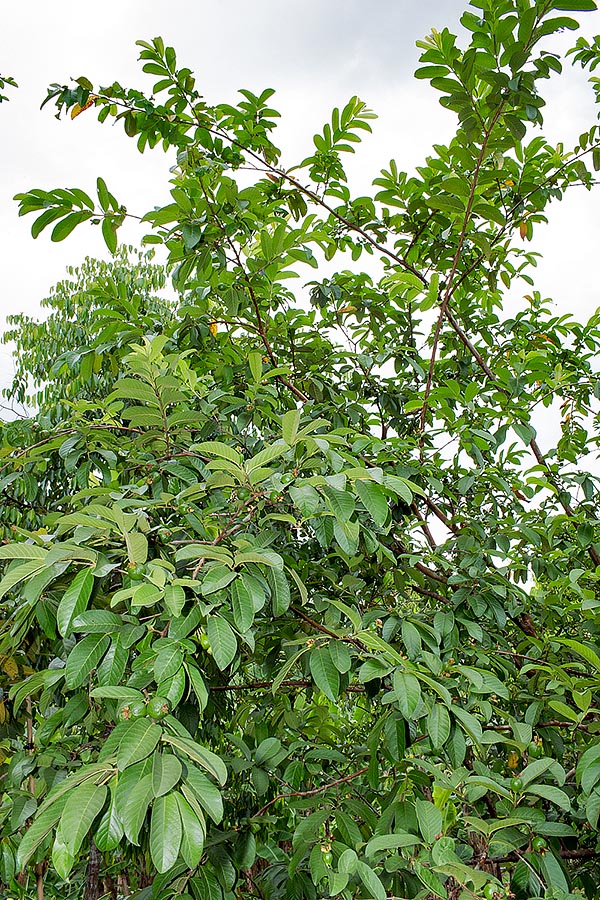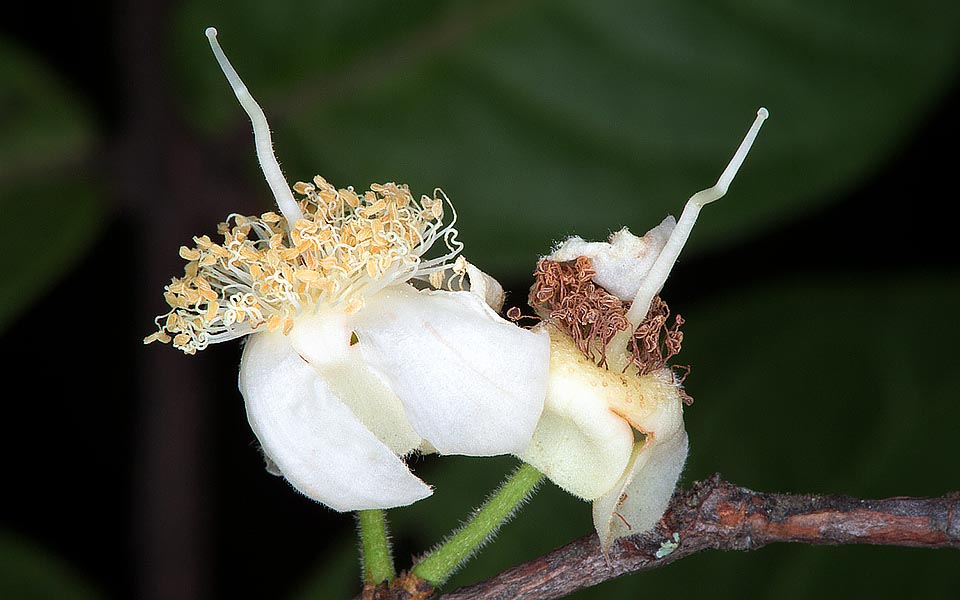Family : Myrtaceae

Text © Pietro Puccio

English translation by Mario Beltramini

The Eugenia stipitata is a 3-12 m very ramified evergreen © Giuseppe Mazza
The genus was dedicated to the memory of the general, diplomat and patron Eugene of Savoy (1663-1736); the specific name is the Latin adjective “stipitatus, a, um” = provided of stipe, with reference to the short peduncle of the inflorescences.
Common names: araza (English); araçá, araçá-boi (Brazil); arazá, arazá-buey (Peru).
The Eugenia stipitata McVaugh (1956) is an evergreen shrub or small tree, 3-12 m tall, very ramified, with reddish bark tending to flake off; the young branches are covered by a brownish down.
The leaves, on short petiole, are simple, opposite, ovate-elliptic with entire margin and pointed apex, 8-16 cm long and 3-8 cm broad, of intense green colour and slightly pubescent above, pale green, pubescent and with rigid, 0,5 mm long, sparse hairs below.
The young leaves are initially of reddish colour.
Axillary flowers solitary or united in racemose inflorescences, on short peduncle, with 0,5-1 cm long dichotomous ramifications, bearing 2-5 couples of bisexual flowers, on a 1-2 cm long pedicel.
Calyx with 4 ovate free sepals, 0,4-0,5 cm long, of yellowish green colour and retroflexed after opening, 4 white obovate petals, 0,8-1 cm long and about 0,5 cm broad, quadrilocular ovary, about 1,1 cm long style and 80-130 stamina about 0,6 cm long. The longistyle shape of the flower, though not completely hindering the self-pollination, favours the crossed fecundation.
The fruit is an almost spherical berry of 5-10 cm of diameter, initially of green colour, then yellow when ripe, with epicarp (the “skin”) thin and pubescent and juicy and aromatic pulp, also that surrounding the seeds, of pale yellow colour. The seeds, in number of 5-15, have a slightly compressed oblong shape, 0,5-2 cm long and 0,5-1,5 cm broad.
It reproduces by seed, that must be planted shortly after the extraction from the pulp having a limited germinability duration, in draining loam, acidic, maintained humid at a temperature of 24-28 °C. Germination times from 2 to 8 months, that may reduced by means of scarification, and first fructification, in the best cultivation conditions, after about 2 years. In order to maintain particular characteristics recourse to grafting is done.

Native to humid forests of Bolivia, northern Brazil, Colombia, Ecuador and Peru, has bisexual flowers with very long style that favours the crossed fecundation © G. Mazza

The fruit, yellow when ripe, is an almost spherical berry of 5-10 cm. It's not good due to the acid pulp to fresh consumption, but is excellent as flavouring, rich of vitamin A, B1 and C, proteins, carbohydrates and for the presence of calcium, iron, magnesium, potassium and zinc. The fructification is continuous, almost without any stop © Giuseppe Mazza
→ To appreciate the biodiversity within MYRTACEAE family please click here.
